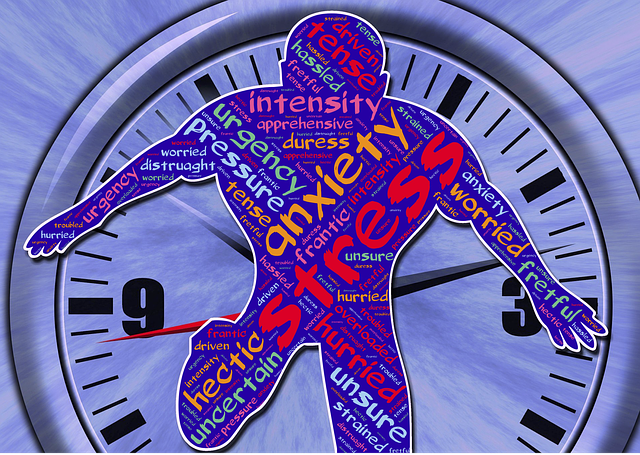Biological approach to anxiety
 The biological approach has two key arguments for the origins of anxiety disorders. First, there is the genetic argument that argues that the disorder is inherited and runs in families. The second argument is that there are neurochemical reasons for anxiety disorders - specifically, levels of noradrenaline and GABA.
The biological approach has two key arguments for the origins of anxiety disorders. First, there is the genetic argument that argues that the disorder is inherited and runs in families. The second argument is that there are neurochemical reasons for anxiety disorders - specifically, levels of noradrenaline and GABA.
Both of these explanations are reductionist, looking to explain the complex behaviours of anxiety disorders with biological mechanisms.
Genetic explanations
Anxiety disorders tend to run in families. This leads psychologists to believe that anxiety disorders may have a genetic origin. One way that this can be studied is through twin studies.
Perna et al (1997) carried out a study of twins who suffered from panic disorder. They found a concordance rate of 73% among monozygotic twins, but 0% in dizygotic twins. These results seem to indicate a significant role of genetic factors in panic disorder. The study was limited, with a sample size of only 120 twin pairs. In addition, some of the twins had diagnosed panic disorder - and others had sporadic panic attacks, but were not diagnosed with the disorder.
Hettema et al (2001) carried out a meta-analysis of genetic research on GAD and panic disorder. There was only a limited number of twin studies available for analysis. These studies yielded heritability rates of 0.43 for panic disorder and 0.32 for generalized anxiety disorder.
Critical thinking about research: Wang et al (2014)
 One of the most common forms of anxiety experienced by teenagers is "math anxiety." Wang et al (2014) wanted to see if math anxiety is the result of what happens in classrooms or whether it is linked to a genetic disposition in some students.
One of the most common forms of anxiety experienced by teenagers is "math anxiety." Wang et al (2014) wanted to see if math anxiety is the result of what happens in classrooms or whether it is linked to a genetic disposition in some students.
The study examined how fraternal (DZ) and identical (MZ) twins differ on measures of math anxiety, The study included 216 identical twins and 298 same-sex fraternal twins from an existing sample that participated in the Western Reserve Reading and Math Projects. The researchers carried out two home-visits when the twins were between about 9 and 15 years old.
All of the twins completed assessments of math anxiety, general anxiety, math problem solving, and reading comprehension. The researchers determined that genetic factors accounted for roughly 40% of the variation in mathematical anxiety, with the remaining being accounted for by environmental factors.
The researchers argued that genetic risk factors for anxiety may lead to poor math performance - and then this may lead to further anxiety - an example of spiraling causality, a positive feedback loop.
Questions to consider
1. What questions or concerns do you have about the study by Wang et al?
2. If the results of this study were shown to be reliable, what does this mean for schools? What should schools then do to help students with math anxiety?
1. What questions or concerns do you have about the study by Wang et al?
There are several potential concerns. First, the study is correlational in nature; therefore, drawing conclusions about causality may be premature, even though it is a relatively large sample. This means that bidirectional ambiguity could be a problem - making it impossible to know if math performance leads to anxiety or vice versa. The study is also done in the US where there is a cultural context for math and anxiety. In addition, as the study was a twin study, no actual gene(s) is/are identified and linked to math anxiety. Finally, one has to question the validity of the various tests that were given with regard to age and gender.
2. If the results of this study were shown to be reliable, what does this mean for schools? What should schools then do to help students with math anxiety?
It means that math anxiety may be linked to generalized anxiety disorder. If this is the case, then helping students to cope with anxiety in a more general approach, rather than focusing on one's relationship with math, would be a better approach to improving math performance.
Association studies
Although these studies seem to indicate that there is a genetic component to anxiety disorders, twin studies do not tell us the "how and why" of genetics. In order to get a better understanding of how genes play a role in anxiety and potentially find a more effective treatment for the disorders, we have to look at association studies.
Donner et al (2008) carried out an association study to determine the role of 13 candidate genes in general anxiety disorder. Their sample was made up of 321 patients and 653 control participants from a Finnish cohort. All participants were genotyped, to determine the frequency of the candidate gene polymorphisms (SNPs) in the anxiety and control groups. Specific alleles of six of the examined genes revealed some evidence for association.
Lonsdorf et al (2009) carried out a quasi-experiment that focused on polymorphisms in two genes thought to play a role in anxiety disorders: the serotonin transporter 5HTT gene and the gene for the enzyme COMT. The 5HTT gene can come in two different versions that differ in their length. The shorter version of the gene is associated with higher neuroticism scores and anxious behavior. The COMT gene is involved in breaking down dopamine. A specific polymorphism in this gene results in higher levels of dopamine in the prefrontal cortex, leading to greater levels of anxiety.
In this experiment, volunteers received a mild electric shock after being shown a picture (A). They were then shown another picture (B) but with no electric shock. The participants learned to fear picture A.
The participants came back into the lab the next day. First, they were shown the same pictures but without any shocks to see if they would still show the fear response. In addition, blood samples were taken to test for the two genetic variations (5 HTT and COMT).
The participants with the shorter version of the serotonin transporter gene developed a very strong physiological fear response to picture A, but participants with a longer version of the gene did not. In addition, participants with the COMT variant were able to very quickly overcome their fear while volunteers with the other variant failed to do so.
The researchers suggest that these findings may indicate that individuals with specific polymorphisms may be more susceptible to anxiety disorders and less responsive to treatment.
Strengths
- Modern research has allowed us to actually locate genetic variations using large sample sizes
- Modern research recognizes the interaction of environmental and biological factors and does not use a solely reductionist approach.
Limitations
- Correlational studies do not establish a cause and effect relationship.
- As with all studies on anxiety, the construct of "anxiety" is operationalized in different ways - and this may mean that there is a lack of construct validity with regard to actual anxiety disorders.
- Twin studies have the problem of population validity – the samples do not necessarily represent the general population.
- Genetic arguments do not account for the variations in symptomology in different cultures.
- It is not yet clear how genetic markers interact.
The Noradrenergic system
Gamma-Aminobutyric acid (GABA) is a neurotransmitter found in the brain which has an inhibitory effect, particularly on the noradrenergic system - that is, neurons that release noradrenaline. Low levels of GABA have been linked to anxiety disorders.
Sanders et al (1995) found that infusions of GABA or GABA receptor agonists (benzodiazapines) into the amygdala decreases fear and anxiety in several animal species.
Malizia et al (1998) carried out PET scans on seven patients with panic disorder and eight healthy controls. They found fewer GABA-receptor sites in patients with panic disorder.
Increased activation in the medial prefrontal cortex has been reported for several types of anxiety disorders. Long et al (2013) carried out a study of 11 panic disorder patients and eight healthy controls without a family history of anxiety disorders. Each participant underwent a magnetic resonance spectroscopy exam. This is very similar to an fMRI but it is able to measure the activity of neurotransmitters. The researchers found lower levels of GABA activity in the medial prefrontal cortex (mPFC) in panic disorder patients.
Research showing that lower levels of GABA are linked to anxiety disorders has led to the use of GABA agonists in the treatment of anxiety disorders. These agonists are called benzodiazepines - and the most common example is Xanax. The following video will give you a quick overview of the drug and its link to GABA.
Drugs not the only treatment
 Boston University (Streeter et al, 2010) carried out a study comparing walkers and yoga practitioners. All of the participants were healthy and had not been diagnosed with anxiety disorders.
Boston University (Streeter et al, 2010) carried out a study comparing walkers and yoga practitioners. All of the participants were healthy and had not been diagnosed with anxiety disorders.
The participants were randomly allocated to either a yoga intervention (n =19) or a walking intervention (n = 15) for 60 minutes, three times a week for 12 weeks. Tests of mood and anxiety were taken at the start of the experiment and then every four weeks. In addition, they were given a magnetic resonance spectroscopy scan each time to measure levels of GABA.
The yoga practitioners reported improved mood and decreased anxiety compared to the walking controls, and the MRS scans showed increased GABA in the brains of the yoga practitioners compared to the walkers. The increase in GABA correlated with the decrease in anxiety scores.
Although this study was not done with people diagnosed with anxiety disorders, it suggests that meditation and yoga may be a viable alternative to Xanex - which, as you will see in the video above, has some serious disadvantages.
Strengths
- There are is animal research that supports the theory that GABA plays a role in alleviating anxiety.
- The practical application of the theories has led to successful drug treatments that have improved some people’s lives.
Limitations
- Correlational research means that causation cannot be established and bidirectional ambiguity cannot be resolved.
- The Treatment Aetiology Fallacy – that is, the mistaken notion that the success of a given treatment reveals the cause of the disorder.
- Biological explanations cannot explain the range of symptoms associated with anxiety disorders. Cultural and cognitive factors may also play a role.

 IB Docs (2) Team
IB Docs (2) Team
